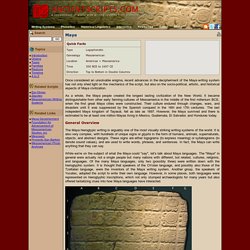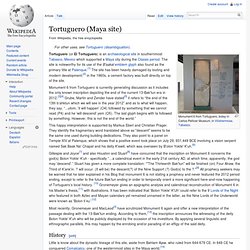

Nahua peoples. The Nahuas /ˈnɑːwɑːz/[1] are a group of indigenous people of Mexico and El Salvador.

Their language of Uto-Aztecan affiliation is called Nahuatl and consists of many more dialects and variants, a number of which are mutually unintelligible. About 1,500,000 Nahua speak Nahuatl and another 1,000,000 speak only Spanish. Evidence suggests the Nahua peoples originated in Aridoamerica, in regions of the present day southwestern United States and northwestern Mexico. Teotihuacan. Coordinates: Teotihuacan /teɪˌoʊtiːwəˈkɑːn/,[1] also written Teotihuacán (Spanish teotiwa'kan ), was a pre-Columbian Mesoamerican city located in the Basin of Mexico, 30 miles (48 km) northeast of modern-day Mexico City, which is today known as the site of many of the most architecturally significant Mesoamerican pyramids built in the pre-Columbian Americas.

Apart from the pyramids, Teotihuacan is also anthropologically significant for its complex, multi-family residential compounds, the Avenue of the Dead, and the small portion of its vibrant murals that have been exceptionally well-preserved. Additionally, Teotihuacan exported a so-called "Thin Orange" pottery style and fine obsidian tools that garnered high prestige and widespread utilization throughout Mesoamerica.[2] Maya script. An inscription in Maya glyphs from the site of Naranjo, relating to the reign of king Itzamnaaj K'awil, 784-810 Maya writing used logograms complemented by a set of syllabic glyphs, somewhat similar in function to modern Japanese writing.

Mayan writing was called "hieroglyphics" or hieroglyphs by early European explorers of the 18th and 19th centuries who did not understand it but found its general appearance reminiscent of Egyptian hieroglyphs, to which the Mayan writing system is not at all related. Although modern Mayan languages use the Latin alphabet as standard, Mayan writing has received official support and promotion by the Mexican government and is taught in universities and public schools in several Mayan speaking areas. Mayan Language Construction. Maya. Once considered an unsolvable enigma, recent advances in the decipherment of the Maya writing system has not only shed light on the mechanics of the script, but also on the socio-political, artistic, and historical aspects of Maya civilization.

As a whole, the Maya people created the longest lasting civilization of the New World. It became distinguishable from other early farming cultures of Mesoamerica in the middle of the first millenium BCE, when the first great Maya cities were constructed. Their culture endured through changes, wars, and disasters until it was suppressed by the Spanish conquest in the 16th and 17th centuries. The last indepedent Maya kingdom of Tayasal, fell as late as 1697.
Piedras Negras (Maya site) Coordinates: Throne 1 of Piedras Negras The name Piedras Negras means "black stones" in Spanish.

Its name in the language of the Classic Maya has been read in Maya inscriptions as Yo'k'ib', meaning "great gateway" or "entrance",[1] considered a possible reference to a large and now dry sinkhole nearby.[2] Some authors think that the name is Paw Stone, but is more likely to be the name of the founder as hieroglyphs on Throne 1 and altar 4 show. Piedras Negras had been populated since the 7th century BC. Trecena. Tonalpohualli. Page 11 reverse from Codex Magliabechiano, showing four day-symbols of the tonalpohualli: (Se = one) Flint/Knife [tecpatl], (Ome = two) Rain [quiahuitl], (Yei = three) Flower [xochitl], and (Nahui = four) Caiman/Crocodile (cipactli), with Spanish descriptions.
Note how closely the Rain day-symbol resembles Tlaloc, the Aztec god of rain and fertility. The tonalpohualli Nahuatl pronunciation: [toːnaɬpoːˈwalːi], a Nahuatl word meaning "count of days", is a 260-day sacred period (often termed a "year") in use in pre-Columbian Mesoamerica, especially among the Aztecs. This calendrical period is neither solar nor lunar, but rather consists of 20 trecena, or 13-day periods. Each trecena is dedicated to and under the auspices of a different deity. Description[edit] Tzolk'in. Month. A month is a unit of time, used with calendars, which was first used and invented in Mesopotamia, as a natural period related to the motion of the Moon; month and Moon are cognates.

The traditional concept arose with the cycle of moon phases; such months (lunations) are synodic months and last approximately 29.53 days. From excavated tally sticks, researchers have deduced that people counted days in relation to the Moon's phases as early as the Paleolithic age. Lunar phase. The phase and libration of the Moon for 2013 at hourly intervals, with music, titles and supplemental graphics.

The Thirteen Heavens. The Thirteen Tones of Evolution The levels of consciousness developed by each Underworld are developed according to a common pattern.

The Maya used to describe this by the notion that a special deity or divine force ruled each of the Thirteen Heavens of the various Underworlds and from the Aztecs we have information about what these deities were: General scheme of the divine forces ruling the Thirteen Heavens or the Seven days and Six nights of divine creation The interesting thing about these thirteen deities ruling the thirteen heavens is that if we look at every other deity, the seven with odd-numbers above, we find that they are forces that nurture the development of a seed. The Mayan Calendar. Tortuguero (Maya site) Tortuguero (or El Tortuguero) is an archaeological site in southernmost Tabasco, Mexico which supported a Maya city during the Classic period.

The site is noteworthy for its use of the B'aakal emblem glyph also found as the primary title at Palenque.[1] The site has been heavily damaged by looting and modern development;[2] in the 1960s, a cement factory was built directly on top of the site. Monument 6 from Tortuguero is currently generating discussion as it includes the only known inscription depicting the end of the current 13-Bak'tun era in 2012.[3][4] Grube, Martin and Zender have stated[5] it refers to “the end of the 13th b’ahktun which we will see in the year 2012” and as to what will happen, they say, “...utom, 'it will happen' (O4) followed by something that we cannot read (P4) and he 'will descend' yem (O5).
Mesoamerican Long Count calendar. The Mesoamerican Long Count calendar is a non-repeating, vigesimal (base-20) and base-18 calendar used by several Pre-Columbian Mesoamerican cultures, most notably the Maya.

For this reason, it is sometimes known as the Maya (or Mayan) Long Count calendar. Using a modified vigesimal tally, the Long Count calendar identifies a day by counting the number of days passed since a mythical creation date that corresponds to August 11, 3114 BCE in the Proleptic Gregorian calendar. [n 1] The Long Count calendar was widely used on monuments. East side of stela C, Quirigua with the mythical creation date of 13 baktuns, 0 katuns, 0 tuns, 0 uinals, 0 kins, 4 Ahau 8 Cumku - August 11, 3114 BCE in the proleptic Gregorian calendar. The recreation of the Global Tree of Life in the Conscious Convergence. Ancient traditions of our planet almost universally looked upon the four geographical directions as Sacred. The origin of this sacredness of the directions is that they since the beginning of time have played a role in the ongoing creation of our planet and its evolution of consciousness.
Naturally then, many peoples all over the world have performed ceremonies to honor these four directions.